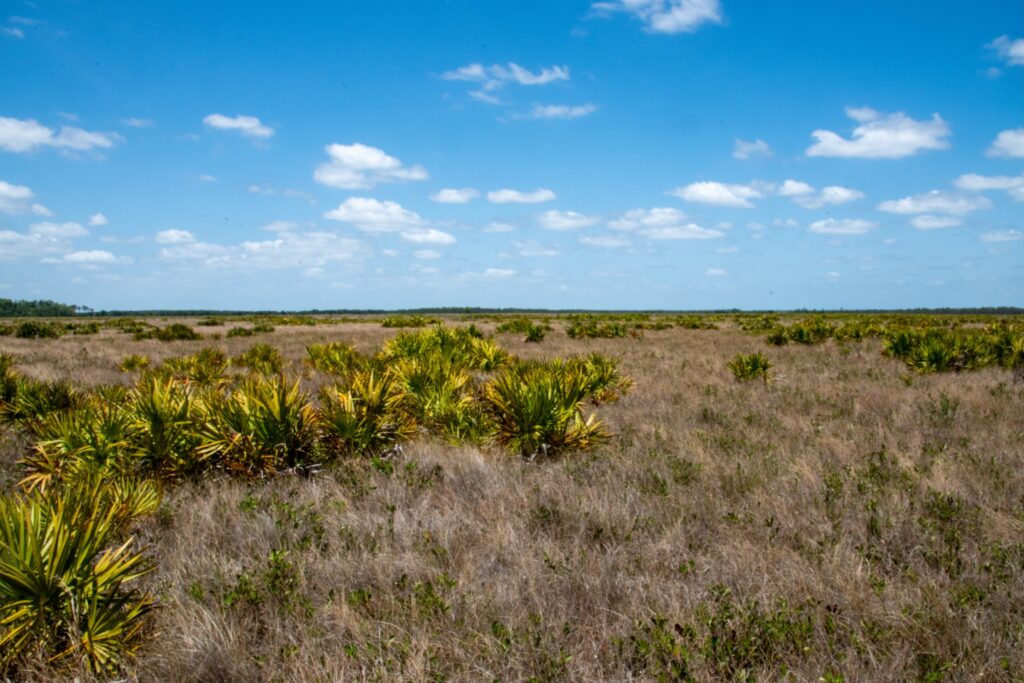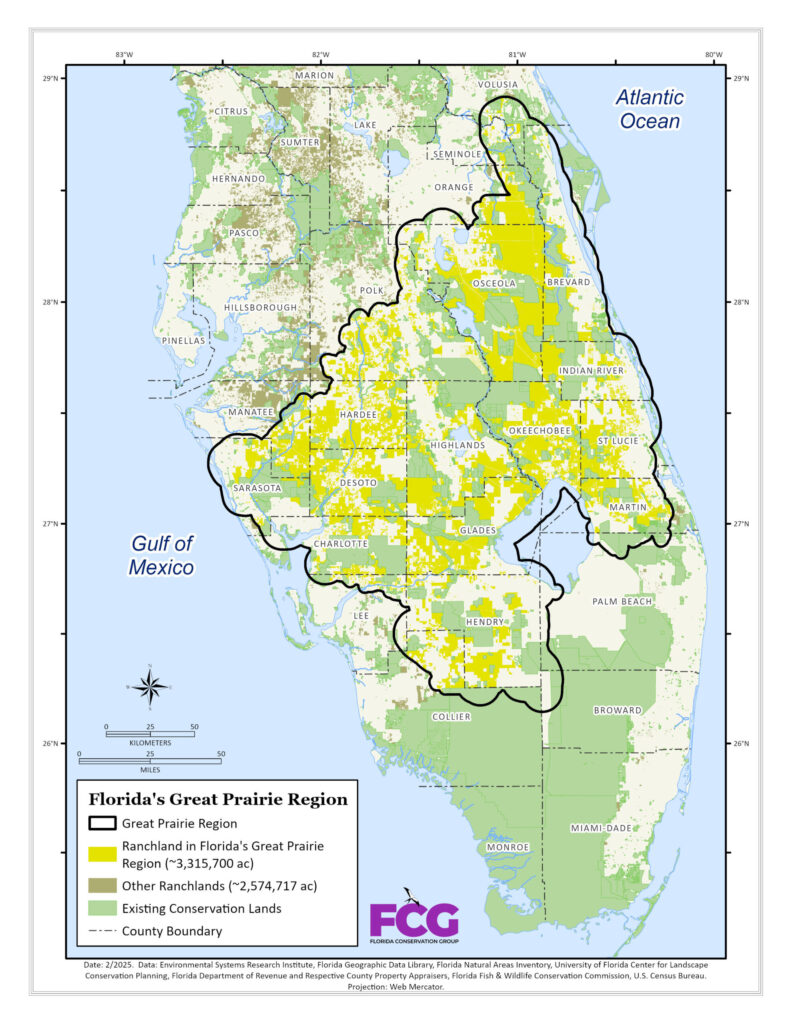Pictured above: Erin Myers, U.S. Fish and Wildlife Service biologist, and Lefty Durando, FCG Chairman and rancher, surveying for the Florida grasshopper sparrow in Okeechobee, Florida.
The Great Florida Prairie—a region occupying much of south-central and interior southwest Florida—is an ecological gem that few Floridians or visitors know. The Prairie is a vast flat land of grasses, low shrubs and occasional trees and hardwood hammocks that support an array of unique and important species, including the Florida grasshopper sparrow, crested caracara, Florida sandhill crane, Florida burrowing owl, gopher tortoise, and many others. These millions of acres are also home to the majority of Florida’s cattle ranches, where vast native grasslands exist alongside species adapted to the dry prairie ecosystem.
The Great Prairie extends from the Kissimmee River watershed (Osceola, Okeechobee, Polk, and Highlands counties) to the Big Prairie (Desoto, Glades, and Charlotte counties) in the Peace River and Fisheating Creek watersheds, and to the Myakka Prairie (Manatee and Sarasota counties). The vast, open floodplain of the upper St. Johns River from Indian River County north to the southern edge of Volusia County is also considered part of this large regional landscape.

Ranching and Conservation in the Great Florida Prairie
Today the Great Florida Prairie is an important center for cattle ranching, with a unique brand of Florida cowboy that has been celebrated in books, stories, and documentaries. An estimated 3.3 million acres of the Prairie are devoted to cattle ranching, a practice that dates back to the 16th century in Florida. Though the era of free range is over, Florida ranchers maintain both the history and unique character of the Florida cowboy and a conservation ethic to continue to manage these lands for ranching, wildlife, and water.
From an ecological perspective, a well-maintained cattle ranch is the most desirable land use in many parts of the southern peninsula, other than purely native habitat. Pastures mimic many of the native prairie’s ecological functions and support wildlife native to the region. Many ranches in the region still maintain native dry prairie, which has been designated as a state conservation priority.
The mix of upland and wetland habitats on ranches and conservation lands in the region store and filter water, significantly contributing to the protection of southern and eastern Florida’s premier watersheds. These include the Kissimmee River and Fisheating Creek, which are the headwaters of the Everglades; the Peace, Myakka, and Caloosahatchee rivers, which are the watershed for Charlotte Harbor; and the headwaters of the St. Johns River.
By dispersing water storage across large areas, these habitats also help provide storm protection and restore water quality. Indeed, Everglades restoration starts in the Great Florida Prairie, and the restoration of the Kissimmee River and protection and management of ranchlands in the Everglades watershed play a key role.
Protecting the Land from Development
Without the ranches, most of the remaining open prairie lands would be lost to development.
The counties containing the dry prairie ecosystem are some of Florida’s most populous and growing, including Manatee, Sarasota, Charlotte, Orange, St. Lucie and Martin. Sprawling suburban development and small acreage “ranchettes” are spreading inland from the coasts into the prairie landscape, pushing cattle ranching into increasingly isolated operations. Even interior counties like Highlands, Polk and Okeechobee are feeling the squeeze, as new residents move inland from built-out coastal communities and to escape the greater risks and costs associated with hurricanes. For example, between 2002 and 2015, Polk County’s farm bureau reported 100,000 acres — about a third of the county’s total agricultural land — had been converted for development.
By 2040, an estimated 1 million additional acres of rural land including ranches could be developed if we don’t work together to protect these lands before they are converted to intensive uses. There are other forces at work too, including labor shortages, potential disease outbreaks, weather extremes and increased storm events, and market fluctuations. All these factors play into the decision-making of whether a family continues ranching or sells their land.
Protecting the Prairie Through Conservation and Agricultural Easements
Conservation or agricultural easements represent the primary option for permanently protecting ranches from development while keeping the property in private ownership and management. Easements allow ranchers to maintain their lands in compatible uses forever, while protecting all the public benefits that society values for open space, wildlife, and water. However, keeping ranching profitable is another key to protecting the Great Florida Prairie. This means working with landowners to increase compatible economic activities, such as water storage and payment for ecosystem services.
Unless these historic dry prairie ranchlands are protected by conservation easements or other conservation agreements, they are likely to be lost to suburban and urban land uses. These alternative land uses, which in most cases would be suburban residential and commercial development, would impact the wildlife habitat, water conservation benefits, and food production that ranches in the Great Florida Prairie provide. The Florida Conservation Group helps agricultural landowners with conservation easements and other programs, and we are dedicated to protecting these lands in the Great Florida Prairie.

